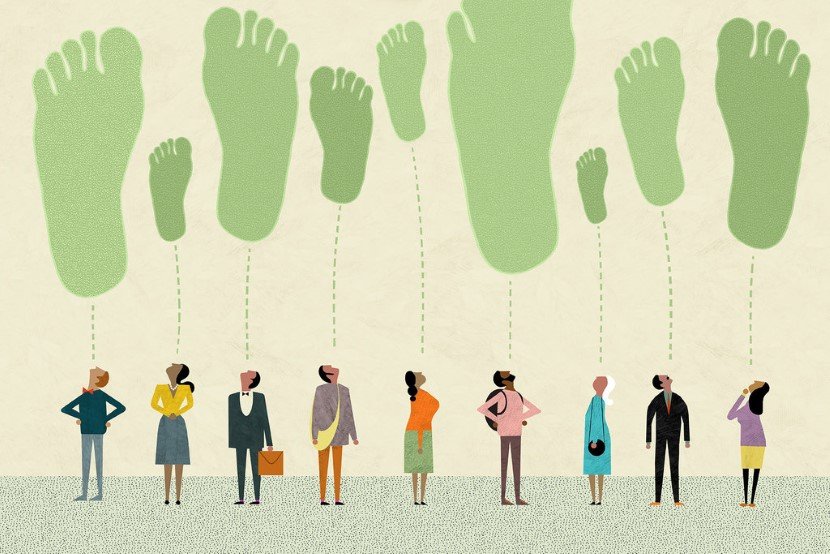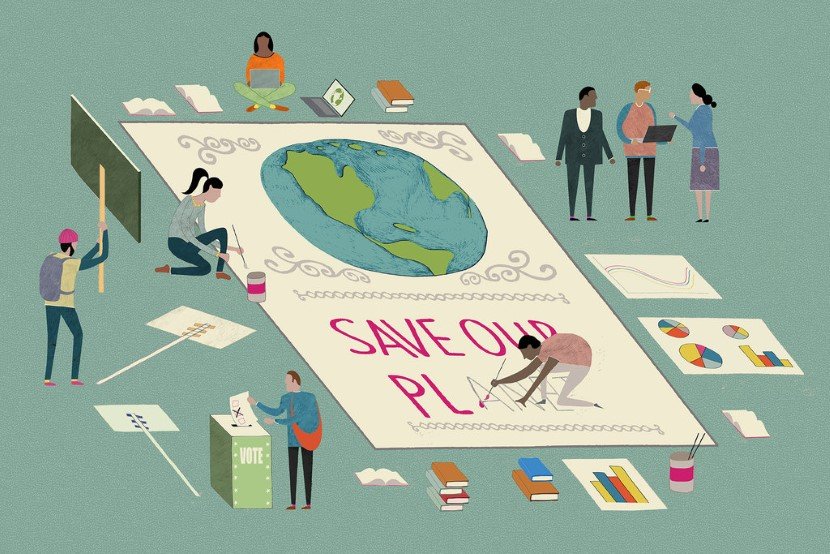Contents
What is a Carbon Footprint?
A carbon footprint is defined as the total amount of carbon and toxic emissions released into the atmosphere as a result of an individual’s or entity’s activities. There are radioactive emissions in the atmosphere, toxic gases, waste that might never degrade, and all of this is ultimately contributing to global warming and other environmental disasters. The most common source of these toxic gases is transportation bodies and factories. The United States alone is known to produce 25% of the toxic gases released into the environment, and that’s only 4% of the world’s population.

Carbon Footprint Calculation is Quite Simple
According to the Deep Decarbonization Pathways project, in order to prevent the Earth from the 2°C global temperature rise, everyone has to make sure to have an annual carbon footprint of not more than 1.87 tons by 2050. Currently, the annual carbon footprint of the US is 18.3 tons while that of China is 8.2 tons.
You can easily calculate your carbon footprint through carbonfootprint.com. Also, the EPA’s calculator can calculate the amount of money you would have to save while taking care of their carbon footprint numbers.
There are four things that you will need to calculate your carbon footprint:
- The energy usage in your home.
- The nature and type of your diet.
- The miles traveled via different transportation units.
- Money spent on shopping.

Ways to Minimize Your Carbon Footprint
There are numerous ways experts have advised to help minimize the carbon footprint on an individual level. A few of them are as follows:
1. At Home
What better place to start reducing toxins from than the place you live in? You would not only be helping the environment but also your and your family’s health, ensuring a long healthy life for all.
- The primary thing to do is an energy inspection to find out the amount of energy consumption that your house does in a routine.
- Turn off unnecessary electric appliances.
- Lower the thermostats of your heaters and raise them up for air conditioners.
- Install low energy consumption appliances, e.g energy-saving light bulbs, and solar panels.
- Get clean electricity through your local retailers. Green-e.org can help you seek certified green energy providers.
2. Through Transportation
Toxic means of transportation have been on the rise for hundreds of years and without a doubt, one of the leading causes of air pollution. Vehicles have filled the atmosphere with innumerable toxins. Whereas some vehicles are energy and fuel-efficient and have minimal emissions, there is still a long way to go before the toxic ones are completely eradicated. Until then, here are a few steps that can help minimize the carbon footprint of your automobiles.
- Drive only when necessary.
- Bicycles and skateboards should be used whenever possible.
- Use public transport instead of private cars.
- Use car sharing apps such as Uber, Lyft.
- Traffic apps such as Waze should be used to prevent traffic congestion routes.
- Handle multiple grocery chores in one trip.
- Use less air conditioning while driving.
- Try buying a hybrid or an electric when purchasing a new car. You can search for cars here which are fuel and hazard efficient.
3. Mindful Shopping
The next thing that should be taken into consideration for carbon footprint minimization is mindful shopping. Following are the things to consider:
- Avoid excessive and needless shopping.
- Keep reusable and environmentally-friendly shopping bags with you.
- Avoid items with unnecessary over-packaging.
- Buy items that are economical and are likely to last longer.
- In case you are shopping for electrical appliances, try to find Energy Star Products which are certified to be more energy efficient.
- For rest of the products try to find companies that are environmentally responsible.
4. Choice of Clothing and Accessories
Clothing has an adverse effect on the planet and is contributing to the rise of the carbon footprint. This is due to the toxic fibers used in manufacturing these clothes and surprisingly, renowned brands such as H&M, Zara and Forever 21 are all responsible for this harmful contribution. Here are some of the ways you can cut down on the unnecessary toxins produced through clothing.
- Do not render to fast fashion. Buy practically, and buy what you need.
- Try to buy vintage and second-hand clothing. They are cheaper and more reliable.
- Wash clothes in cold water. You can save up to 500 pounds of carbon dioxide by using cold water for laundry twice a week. This is because enzymes present in the detergent work readily with cold work and show better results.
5. Food Consumption
The way food is processed and consumed has a role to play in the rise of carbon footprint as well. Here is how you can deal with it:
- Try consuming primary food sources, which are any crops capable of producing their own food. Secondary consumers such as cattle and other animals that are used in the manufacture of dairy and meat contribute to 14.5% of greenhouse gases. The feed used for sheep and cattle produces methane while processing, which is 25 times more deadly than carbon dioxide.
- You can go to Meatless Mondays and try to avoid the consumption of meat.
- Try buying local food. The food brought from miles away causes a number of emissions during delivery. Springmann said “This ‘eat local’ argument, I would take it with a pinch of salt,”
- Use organic food. A study shows that organic foods take up less energy than conventional ones, however, they do take up more land for production and therefore, lead up to the same amount of greenhouse gases.
- Buy food in bulk.
- Food waste should be handled efficiently. Most of the compost thrown away can be deadly for the environment. However, if disposed off efficiently, most of it can be used as an exceptional fertilizer and therefore maneuvering more food growth. For the residents of New York City, you can find some compost drop off site here.
6. Minimizing Air Travel
It is no surprise that much like other motor vehicles, airplanes play an huge part in intoxicating the environment. You can do your part by:
- Avoiding unnecessary air travels and vacations.
- Travelling on the economy class, not only is it cheaper but also less intoxicating. Business-class is responsible for three times as many emissions than the economy class.
- Try taking direct flights and avoid connecting flights. Landings and takeoffs consume a large quantity of fuel.
- If it is impossible to cancel your air travel, offset carbon emissions of your travel. Offset is paying an organization for reducing carbon emissions while handling your task. If one offsets one ton of carbon, the offset will be responsible for destroying one ton of greenhouse gases. A specifically designed calculator is used for the estimation of carbon emissions of your flight and the amount required to offset them. If a person is making a round trip from New York to Los Angeles, the flight would produce about 1.5 tons of carbon dioxide and it would require about $43 to offset them. The money contributed goes to companies that help to manufacture environmentally-friendly equipment. This includes Myclimate, which funds energy-efficient stoves in Rwanda, installs solar power in the Dominican Republic, and replaces old heating systems with energy-efficient heat pumps in Switzerland. Another company, Cotap plants sustainable crops in countries like India, Malawai Mozambique, Uganda, and Nicaragua that are designed for the absorption of carbon dioxide from its environment.
7. Waste Disposal
The amount of waste disposal all over the world is way more than you think. On average, Americans dispose of 40 percent of the food they buy. There are a lot of ways this waste could be controlled and reduced:
- Make a reasonable amount of stock of food which is just enough to not slather your kitchen with the entire grocery shop, but enough to stock the fridge
- Make sure to not buy in bulk when you cannot finish the entire product before it goes bad.
- Make sure to cook just the right amount for the family. Excess food is usually wasted and if there is enough food on the table that might head for the trash, it is better to give some away to the needy; two birds, one stone.
- Utilize your leftover food to make something new rather than throwing it away.
- Another way to save food waste is to freeze it and take it out when you’re ready to eat it.
- Pack the extra food you order in a restaurant and take it home.
- Quit using disposable utensils. It is quite economical to wash your dishes with a dishwasher which is environmentally friendly
8. Reuse and Recycle
Out of 258 million tons of waste generated by Americans, 169 million tons ends up in landfills and heaps, according to a 2014 EPA report. This year, Americans have disposed off 29 million tons of municipal waste, this saved energy is enough to generate 25 million homes. Yet most of the waste still ends up in incinerators.
Following are some of the ways to make sure that this waste is disposed off the right way:
- Recycle everything possible; from paper to steel cans and tins.
- Donate the fixed electronics rather than throwing them away in the trash.
- Collect and give dry cell batteries to local municipal authorities.
- Clean and rinse food containers before throwing them away. Make sure you first find a good use, and if you fail to do so, only then throw them out.
- Look for a number on the inside of a triangle on the bottom of plastic containers. This number shows the type of resins used in the manufacture of the item and whether it is recyclable where you live or not.
Government Role in reducing the Carbon Footprint
The government plays an important role in determining how to deal with environmental disasters and on how to lower the carbon footprint. It is important to know which running candidate is suitable and environmentally aware enough to take precautionary measures. Hence, thinking that your vote does not matter is wrong because it does and every individual has a significant role to play in the building of their country’s economy and a healthy world as a whole. So, be aware and choose a candidate for the benefit not just for the country but our world as well.
All Image Credits: Adam Simpson

